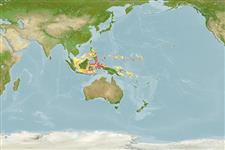Classification / Names
ชื่อสามัญ | ชื่อพ้อง | Catalog of Fishes(สกุล, ชนิด) | ITIS | CoL | WoRMS | Cloffa
>
Gobiiformes (Gobies) >
Gobiidae (Gobies) > Gobiinae
Etymology: Eviota: No etymology given, suggested by Christopher Scharpt: from Latin 'eu' for 'true' and 'iota' for anything very small, in combination 'truly very small' referring to it as being the smallest vertebrate at the time it has benn described by Jenkins (thus, making the suggestion by Scharpt plausible; pinocchioi: Named after Carlo Collodi’s fictional character Pinocchio; referring to the exceptionally long anterior tubular nares in this species.
Eponymy: Pinocchio is a fictional character created by Carlo Collodi in his childrens’ novel: The Adventures of Pinocchio (1883). [...] (Ref. 128868), visit book page.
Environment: milieu / climate zone / depth range / distribution range
นิเวศวิทยา
เกี่ยวกับทะเล,น้ำเค็ม เกี่ยวกับหินโสโครก; ระดับความลึก 14 - 73 m (Ref. 92345). Tropical
Western Pacific: Palau and Indonesia.
ขนาด / น้ำหนัก / Age
Maturity: Lm ? range ? - ? cm
Max length : 1.7 cm SL เพศผู้/กระเทย; (Ref. 92345)
Short description
เครื่องมือที่ใช้ในการแยกชนิดสัตว์,สิ่งมีชีวิตออกจากกัน | สัณฐานวิทยา | ความยาวต่างๆ
เงี่ยงครีบหลัง (รวม) : 7; ก้านครีบอ่อนที่หาง (รวม) : 9; เงี่ยงครีบก้น: 1; ก้านครีบอ่อนที่ก้น: 8; สัตว์มีกระดูกสันหลัง: 25. This species is distinguished from its congeners by the following set of characters: cephalic sensory-pore system always lacking POP and IT pores, PITO and AITO pores fused 50% of time; dorsal/anal fin-ray formula 8/8; unbranched pectoral-fin rays; 4th pelvic-fin ray bifurcated with each branch about 50% of the total length of the ray; unbranched 5th pelvic-fin ray 6.5-15.3 (11.0%) of 4th; in males, dorsal-fin spines are filamentous, very long tubular anterior nares, length almost equal to pupil diameter, reaching well anterior to the upper lip, and black; in life body translucent and crossed by six narrow red bands and when preserved, devoid of obvious dark marks on body (Ref. 92345).
Found in vertical drop-off with caves and sandy and slope with some Halimeda (Ref. 92345).
Life cycle and mating behavior
วัยเจริญพันธุ์ | การสืบพันธุ์ | การวางไข่ | เซลสืบพันธ์ของเพศเมีย(ไข่) | ความดกของไข่ | ตัวอ่อน
Greenfield, D.W. and R. Winterbottom, 2012. Two new dwarfgobies from the Southwestern Pacific Ocean (Teleostei: Gobiidae: Eviota). Zootaxa 3572:33-42. (Ref. 92345)
IUCN Red List Status (Ref. 130435: Version 2024-1)
Threat to humans
Harmless
Human uses
เครื่องมือ
Special reports
Download XML
แหล่งที่มาจากอินเตอร์เน็ต
Estimates based on models
Preferred temperature (Ref.
123201): 27.2 - 29, mean 28.7 °C (based on 20 cells).
Phylogenetic diversity index (Ref.
82804): PD
50 = 0.5000 [Uniqueness, from 0.5 = low to 2.0 = high].
Bayesian length-weight: a=0.01023 (0.00477 - 0.02194), b=3.01 (2.83 - 3.19), in cm total length, based on LWR estimates for this (Sub)family-body shape (Ref.
93245).
ระดับชั้นอาหาร (Ref.
69278): 3.0 ±0.3 se; based on size and trophs of closest relatives
Fishing Vulnerability (Ref.
59153): Low vulnerability (10 of 100).
